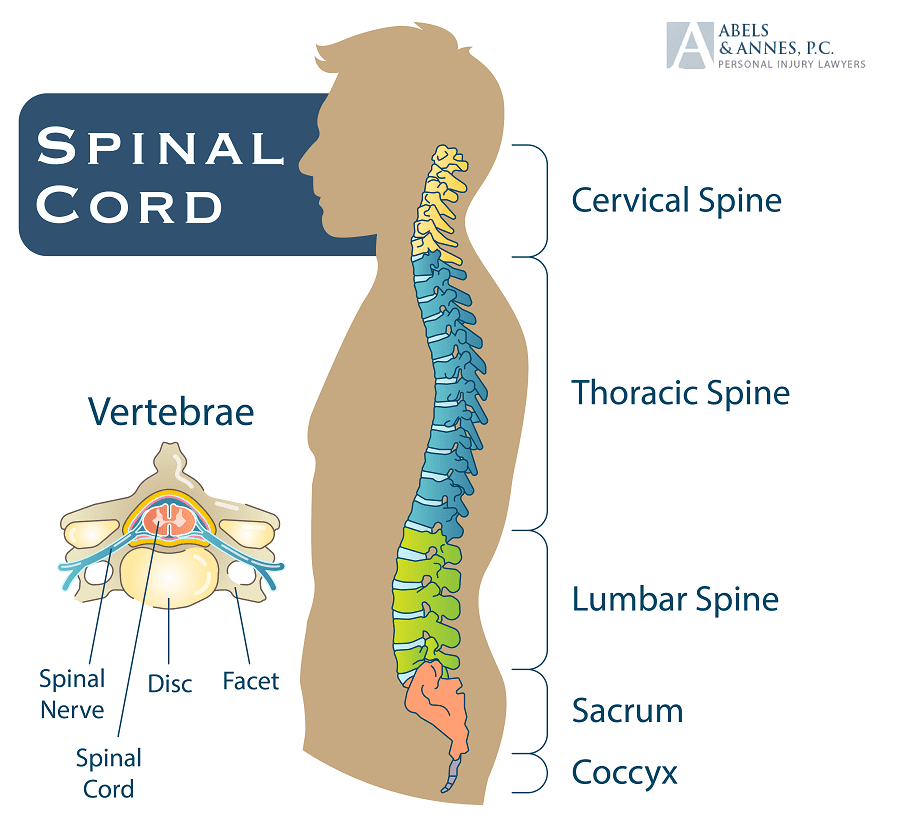Tailbone Injury from a Car Accident
You are driving along, minding your own business, when suddenly, BAM! Another car T-bones yours. You’re dazed and confused, and your body is in pain. One of the most common injuries from a car accident is a tailbone injury. Also known as a coccyx injury, this type of injury can be extremely painful and debilitating.
What is a Tailbone Injury?
The tailbone is a small, triangular bone located at the base of the spine. It is made up of four fused vertebrae and is responsible for providing support and stability to the pelvis. A tailbone injury can occur when the tailbone is subjected to a sudden force, such as a fall or a car accident. This force can cause the tailbone to fracture, dislocate, or become bruised.
Tailbone injuries can range in severity from mild to severe. Mild injuries may only cause minor pain and discomfort, while severe injuries can cause intense pain, bruising, swelling, and difficulty sitting or walking.
Symptoms of a Tailbone Injury
The most common symptom of a tailbone injury is pain. The pain may be sharp and stabbing, or it may be a dull ache. It may also worsen when you sit, stand, or walk. Other symptoms of a tailbone injury include:
- Bruising or swelling around the tailbone
- Difficulty sitting or walking
- Numbness or tingling in the buttocks or legs
- Pain during bowel movements
Diagnosis and Treatment of a Tailbone Injury
If you think you may have a tailbone injury, it is important to see a doctor for diagnosis and treatment. The doctor will ask you about your symptoms and medical history, and may perform a physical examination. The doctor may also order an X-ray or MRI to confirm the diagnosis.
Treatment for a tailbone injury will depend on the severity of the injury. Mild injuries may only require rest and over-the-counter pain medication. More severe injuries may require surgery to repair the damaged tailbone.
In addition to medical treatment, there are a number of things you can do at home to help relieve the pain and discomfort of a tailbone injury. These include:
- Applying ice to the area
- Taking over-the-counter pain medication
- Sitting on a donut-shaped cushion
- Avoiding activities that aggravate the pain
Preventing Tailbone Injuries
The best way to prevent a tailbone injury is to avoid falls and other accidents. However, if you are involved in a car accident, there are a few things you can do to help protect your tailbone.
- Wear a seatbelt every time you are in a car.
- Adjust your seat so that you are sitting up straight and your feet are flat on the floor.
- Avoid sitting on hard surfaces for long periods of time.
- If you must sit for long periods of time, try to take breaks every 20-30 minutes to stand up and walk around.
- Pain in the lower back, especially when sitting or lying down
- Bruising or swelling around the tailbone
- Tenderness to the touch on the tailbone
- Difficulty with bowel movements
- Numbness or tingling in the buttocks or legs
- Direct Impact: The sheer force of the collision can directly strike your tailbone, causing it to bruise or fracture.
- Compression: As your body is thrust forward and back during the accident, the surrounding muscles can compress your tailbone, leading to a bruised or fractured tailbone.
- Hyperextension: In some cases, the impact can cause your lower back to hyperextend, resulting in a dislocated tailbone. This occurs when the tailbone is forced backward out of its normal position.
- Persistent pain in the tailbone area
- Aggravated pain when sitting or lying down
- Tenderness and swelling around the tailbone
- Difficulty walking or standing
- Numbness or tingling in the legs
- Rest: Give your tailbone the rest it needs to heal. Avoid prolonged sitting or standing.
- Ice: Apply ice packs to the injured area to reduce swelling and inflammation.
- Heat: After a few days, you can switch to heat therapy to promote blood flow and healing.
- Pain Medication: Over-the-counter pain relievers, such as ibuprofen or acetaminophen, can help manage pain.
- Physical Therapy: A physical therapist can teach you exercises to strengthen the muscles around your tailbone and improve mobility.
- Pain when sitting, standing, or lying down
- Bruising or swelling around the tailbone
- Numbness or tingling in the buttocks or legs
- Difficulty with bowel movements
- Use a seat cushion when sitting for long periods of time.
- Avoid sitting on hard surfaces.
- Get up and move around every 20-30 minutes.
- Strengthen the muscles around your tailbone with exercises such as bridges and squats.
- Pain when sitting or lying down
- Bruising or swelling around the tailbone
- Difficulty walking or moving around
- Numbness or tingling in the legs or feet
- Wearing a seatbelt: Seatbelts help to keep you in place during a collision, which can help to protect your tailbone from injury.
- Maintaining good posture: Good posture can help to reduce the amount of pressure on your tailbone.
- Having regular exercise: Exercise can help to strengthen the muscles around your tailbone, which can help to protect it from injury.
- Avoiding falls: Falls are a common cause of tailbone injuries. Be careful when walking or running on slippery surfaces, and avoid jumping from high places.
- Using a coccyx cushion: A coccyx cushion is a specially designed cushion that can help to reduce pressure on your tailbone.
- Losing weight: If you are overweight or obese, losing weight can help to reduce the amount of pressure on your tailbone.
- Quitting smoking: Smoking can damage the bones and muscles around your tailbone, making it more susceptible to injury.
- Eating a healthy diet: Eating a healthy diet can help to keep your bones and muscles strong and healthy.
- Rest: Rest is one of the most important things you can do to help your tailbone injury heal.
- Ice: Applying ice to your tailbone can help to reduce pain and swelling.
- Heat: Applying heat to your tailbone can help to relax the muscles and relieve pain.
- Sitz baths: Sitz baths are warm baths that can help to soothe the pain and discomfort of a tailbone injury.
- Pain relievers: Over-the-counter pain relievers, such as ibuprofen or acetaminophen, can help to relieve pain.
- Physical therapy: Physical therapy can help to strengthen the muscles around your tailbone and improve your posture.
- Surgery: In some cases, surgery may be necessary to repair a severe tailbone injury.
Conclusion
Tailbone injuries can be painful and debilitating, but they are usually not serious. With proper treatment and care, most people can recover from a tailbone injury within a few weeks. However, if you are experiencing severe pain or other symptoms, it is important to see a doctor right away.
Tailbone Injury from Car Accident: Symptoms and Recovery
Tailbone injuries in car accidents are unfortunately quite common. These can range from minor bruises to severe fractures that can cause chronic pain. If you’re experiencing pain in your lower back or difficulty sitting, it’s essential to seek medical attention to rule out a tailbone injury.
Symptoms of a Tailbone Injury
Symptoms of a tailbone injury may vary, but some of the most common include:
Sitting Discomfort After a Tailbone Injury
Sitting discomfort is one of the most common and persistent symptoms of a tailbone injury. This is because the tailbone is responsible for supporting the weight of the upper body when sitting. The pain can be sharp and stabbing, or it can be more of a dull ache. It can be difficult to find a comfortable position to sit, and even sitting for short periods of time can be painful. The discomfort may worsen after prolonged sitting, such as during a long car ride or at work.
In severe cases, the pain may be so severe that it makes it difficult to sit or stand. This can have a significant impact on daily life, interfering with work, school, and social activities. Sitting on a donut-shaped cushion can help relieve pressure on the tailbone and provide some comfort. Additionally, applying ice packs or heat to the area can help reduce pain and inflammation.
If you are experiencing sitting discomfort after a tailbone injury, it is important to see a doctor to rule out any other underlying conditions. Treatment options may include pain medication, physical therapy, and injections. In some cases, surgery may be necessary to repair a fractured tailbone.
Tailbone Injury Car Accident: A Journey through its Causes, Symptoms, and Relief
Life’s unpredictable twists and turns can take a toll on our bodies, and a tailbone injury from a car accident is one such unfortunate event. The intense impact during a collision can send shockwaves through your body, leaving your tailbone—the triangular bone at the base of your spine—bruised, fractured, or dislocated.
Causes of a Tailbone Injury in a Car Accident
Understanding the culprit behind your tailbone injury is the first step towards healing. In the unfortunate event of a car accident, the sudden impact can wreak havoc on your tailbone in various ways:
Recognizing the Warning Signs: Tailbone Injury Symptoms
Identifying the symptoms of a tailbone injury is crucial for timely treatment. If you’ve been involved in a car accident, keep an eye out for these telltale signs:
Finding Relief from Tailbone Pain
While recovering from a tailbone injury can be an arduous journey, there are ways to alleviate the pain and get back on your feet. Here are some helpful tips:
Tailbone Injuries: A Pain in the Posterior
After a jarring car accident, you might have a nagging pain in your backside that just won’t go away. It’s not your imagination – you could have injured your tailbone, the small bone at the base of your spine. Tailbone injuries aren’t uncommon, and while they’re usually not life-threatening, they can be downright uncomfortable.
If you suspect you’ve injured your tailbone, it’s important to seek medical attention to rule out other, more serious injuries. A doctor will perform a physical exam and ask about your symptoms to make a diagnosis.
Diagnosis of a Tailbone Injury
To diagnose a tailbone injury, your doctor will likely perform a physical exam and ask about your medical history. They may also order X-rays to get a better look at the bone. X-rays can help rule out other injuries, such as a fracture or dislocation. However, X-rays may not always show a tailbone injury, especially if it’s a minor one.
Your doctor may also perform a digital rectal exam or a vaginal exam to check for tenderness or swelling in the area. These exams can be uncomfortable, but they’re usually necessary to rule out other conditions.
Treatment for a Tailbone Injury
Treatment for a tailbone injury typically involves rest, pain medication, and physical therapy. Rest is important to allow the bone to heal. Pain medication can help reduce discomfort. And physical therapy can help strengthen the muscles around the tailbone and improve range of motion.
In some cases, surgery may be necessary to repair a severely damaged tailbone. However, surgery is rarely necessary.
Prevention of Tailbone Injuries
Tailbone injuries can be difficult to prevent, but there are some things you can do to reduce your risk. For example, you should always wear a seatbelt when driving or riding in a car. And if you’re involved in a car accident, be sure to seek medical attention to rule out any injuries, including a tailbone injury.
Tailbone injuries can be a real pain, but they’re usually not serious. With proper treatment, most people recover completely. So if you’re experiencing pain in your tailbone, don’t hesitate to see a doctor.
Tailbone Injury from Car Accident: A Comprehensive Guide
If you’ve recently been involved in a car accident, you may be suffering from a painful tailbone injury. This type of injury is often the result of a sudden impact that forces the tailbone to slam into the seat, causing a fracture, dislocation, or bruising. While tailbone injuries can be excruciating, with the right care and treatment, you can get back on your feet in no time.
Symptoms of a Tailbone Injury
The symptoms of a tailbone injury can vary in severity depending on the extent of the damage. Common symptoms include:
Treatment for a Tailbone Injury
Treatment options for a tailbone injury focus on pain management and include rest, pain medication, and physical therapy. Your doctor may also recommend using a donut-shaped cushion to reduce pressure on the tailbone and ice packs to help reduce swelling.
Physical Therapy for a Tailbone Injury
Physical therapy can be an effective way to improve your range of motion, reduce pain, and speed up your recovery. Your physical therapist will teach you exercises to strengthen the muscles around your tailbone and improve your posture. They may also use manual techniques to manipulate the tailbone and relieve pain.
How Long Does It Take to Recover from a Tailbone Injury?
The recovery time for a tailbone injury can vary depending on the severity of the injury. Most people start to feel better within a few weeks, but it can take several months for the pain to completely go away. Be patient with yourself and follow your doctor’s instructions carefully to ensure a full and speedy recovery.
Tailbone Injury from Car Accident
A tailbone injury, also known as a coccyx injury, is a painful and debilitating condition that can result from a car accident. The tailbone is a small, triangular bone located at the base of the spine. It is responsible for providing support and stability to the spine and pelvis. When the tailbone is injured, it can cause a variety of symptoms, including pain, swelling, bruising, and difficulty sitting or walking.
Treatment for a Tailbone Injury
Treatment for a tailbone injury typically involves rest, ice, and pain medication. In some cases, physical therapy may be recommended to help strengthen the muscles around the tailbone and improve range of motion. In severe cases, surgery may be necessary to repair a fractured or dislocated tailbone.
Recovery Time for a Tailbone Injury
Recovery time for a tailbone injury varies based on the severity of the injury. Mild injuries may take a few weeks to heal, while more severe injuries may take several months or even longer. During the recovery period, it is important to follow the doctor’s instructions for rest and activity. Avoiding activities that put pressure on the tailbone, such as sitting for long periods of time or participating in high-impact sports, can help to speed up the healing process.
Long-Term Effects of a Tailbone Injury
In most cases, a tailbone injury will heal completely with no long-term effects. However, in some cases, the injury may cause chronic pain or other problems. If you are experiencing persistent pain or other symptoms after a tailbone injury, it is important to see a doctor to rule out any underlying problems.
Preventing Tailbone Injuries
There are a few things you can do to help prevent tailbone injuries, including:
Tailbone Injury Car Accident: What You Need to Know
Tailbone injuries sustained in car crashes are no laughing matter. That small bone tucked at the bottom of your spine, also known as the coccyx, can pack a lot of pain when injured. It acts like a shock absorber, cushioning your spine during everyday movements like sitting, walking, and bowel movements. However, the impact of a car accident can put immense stress on your tailbone, potentially leading to severe injuries that require medical attention.
The symptoms of a tailbone injury can vary depending on the severity of the impact. Some common signs include pain while sitting, standing, or walking; tenderness and swelling around the tailbone; and bruising or skin discoloration in the area. If you’ve been in a car accident and are experiencing these symptoms, it’s vital to seek medical attention promptly.
Complications of a Tailbone Injury
In most cases, tailbone injuries heal with time and rest. But in rare instances, severe injuries can lead to complications, including:
Nerve Damage
The tailbone is located near several nerves that control sensation and movement in the lower body. A severe tailbone injury can damage these nerves, leading to numbness, tingling, or weakness in the legs or buttocks.
Infection
An open wound or puncture to the tailbone can increase the risk of infection. If left untreated, an infection can spread to the surrounding tissues and bones, leading to serious health complications.
Chronic Pain
Some tailbone injuries can result in chronic pain that persists even after the initial injury has healed. This pain can make it difficult to perform everyday activities, affecting your quality of life.
Bowel and Bladder Problems
In rare cases, a tailbone injury can affect the nerves that control bowel and bladder function. This can lead to problems with constipation, incontinence, or retention.
Sexual Dysfunction
A tailbone injury can also affect the nerves that control sexual function, potentially leading to erectile dysfunction or other sexual problems.
Tailbone Injury in Car Accidents: A Guide to Prevention, Diagnosis, and Treatment
Tailbone injuries are no laughing matter. They can leave you in a lot of pain and make it difficult to sit or move around. If you’ve been in a car accident and you’re experiencing tailbone pain, it’s important to see a doctor right away. Early diagnosis and treatment can help you recover faster and prevent long-term complications.
Symptoms of Tailbone Injury
The symptoms of a tailbone injury can vary depending on the severity of the injury. Some common symptoms include:
Causes of Tailbone Injury
Tailbone injuries are most commonly caused by falls or direct blows to the tailbone. Car accidents are a common cause of tailbone injuries, especially rear-end collisions. When a car is hit from behind, the force of the impact can drive the tailbone into the seat, causing injury.
Prevention of Tailbone Injuries in Car Accidents
While tailbone injuries cannot always be prevented, there are some things you can do to reduce your risk, such as:
Diagnosis of Tailbone Injury
Your doctor will diagnose a tailbone injury based on your symptoms and a physical exam. Your doctor may also order an X-ray or MRI to confirm the diagnosis.
Treatment of Tailbone Injury
The treatment for a tailbone injury will vary depending on the severity of the injury. Some common treatments include:





Leave a Reply